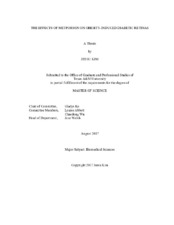| dc.description.abstract | Diabetic retinopathy is a major secondary complication of type 2 diabetes. To regulate blood glucose levels in type 2 diabetic patients, metformin is popularly prescribed as an oral drug in mono- and combination therapies. Metformin was used as a responsive and preventative drug on high-fat diet (HFD) induced obese mice that emulate type 2 diabetes. Body weight was monitored weekly and systemic glucose levels including resting blood glucose levels, the glucose tolerance test, and the insulin resistance test were measured monthly. The electroretinogram (ERG) was used to measure the retinal light responses, immunohistochemistry to quantify changes in retinal protein expression, western blot to assess inflammatory markers, and fluorescein angiography to measure neovascularization.
HFD-fed mice became hyperglycemic after 2 months of feeding regimen. Metformin treatment following hyperglycemia slowed body weight gain and restored systemic glucose levels to control levels. Retinal function measured by ERG showed decreased amplitudes and delayed implicit times in oscillatory potentials after 1 month of HFD and decreased amplitudes and delayed implicit times in a-wave, b-wave, and oscillatory potentials starting 2 months of HFD. Metformin treatment after 2 months of HFD was not able to restore ERG responses in HFD-fed mice. Furthermore, metformin treatment was not able to recover HFD-induced neovascularization. However, metformin treatment for the last 4 months in mice fed a HFD for 6 months was able to reduce inflammatory marker expression and the immunofluorescent proteins affected by HFD-feeding. HFD-fed mice treated with metformin from the beginning of feeding regimen as a preventative strategy not only showed slower weight gain but also do not become hyperglycemic. However, this preventative strategy did not prevent the HFD-induced retinal dysfunction measured by ERG even after 3 months of treatment. Furthermore, some HFD-induced changes in retinal protein expression began after 1 month of HFD-treatment, but metformin treatment concurrent with HFD was not able to prevent HFD-induced changes. | en |


